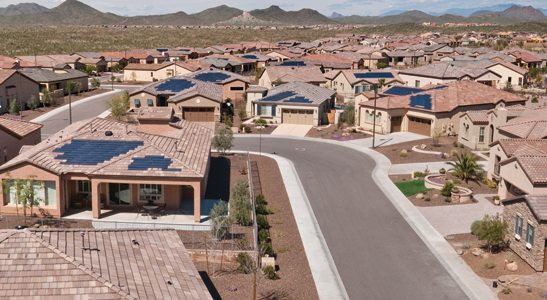With the residential market suffering through the Tepid Economic Recovery, homebuilders are devising ways to bring customers back to their new Master Planned Communities. These days, the magic word Is “Green,” as in sustainable. But it also represents energy and money savings for homebuyers.
In the Valley, Shea Homes launched its green initiative (Shea Green Certified) in the fall of 2007. Trilogy homes at Vistancia (601 sold to date) and Encanterra (285 sold) are built according to those standards, which means all homes come standard with more than 20 green energy and cost saving features. American Solar Electric, Arizona’s largest residential solar integrator, has partnered with Trilogy to provide solar roof tiles to all its homes that are built with the Shea Green Certified — Ultra Package.
Meritage Homes is selling residences at two of its communities — Lyon’s Gate in Gilbert and Weston Ranch in Glendale — that include a high-tech package of sustainable features included in the base price of the home. The future of new homebuilding, with respect to energy efficiency, water conservation, sustainability and green building practices, appears to be a national trend, and even more so in Metro Phoenix.
“In addition to Meritage Homes, Joseph Carl Homes has really distinguished itself with its green and solar features being offered at the CantaMia development in Goodyear,” says Dustin C. Jones, a Phoenix lawyer who publishes the Livability Law Blog. “It has seen a record number of individuals visit the active adult community since its grand opening. I believe that local homebuilders are seeing the need to distinguish themselves from the glut of foreclosed homes in the market and ‘greening up’ is one way to do so.”
Some of Meritage’s features include ECHO Solar Electric/Thermal Systems, spray foam insulation, super high-performance windows, energy-efficient lighting, weather-sensing irrigation, high-performance plumbing fixtures, and a 14 Seer air conditioning unit. All of these features are included in homes from about 1,640 square feet to 3,062 square feet and starting in the $170,000s.
“We spent the last two years working with the EPA, DOA (Department of Agriculture), and building science experts to revolutionize the functionality of a home, while maintaining its price competitiveness,” says C.R. Herro, vice president of environmental affairs for Meritage Homes. “But at the same time, ‘green’ has become a marketing gimmick for everything from soap to homes; that has confused and jaded a lot of consumers. The real work is in allowing consumers to make a more informed decision.”
With the move to green master planned communities, homebuilders and homebuyers both benefit from cost savings. Some homebuilders, such as Arizona-based Robson Communities, are partnering with companies that produce energy-saving products.
Robson also has partnered with American Solar to offer solar electric systems at two of its popular active adult communities, Pebble Creek in Goodyear and Quail Creek in Sahuarita. New homebuyers are also able to select either a 2.5- or 4-kilowatt grid-connected solar electric system at the time they purchase their homes. These systems save $600 and $950 a year, respectively.
“Building green master planned communities is a win-win for everyone,” Jones says. “Not only does the consumer benefit, but the community as a whole. Oftentimes, one can lose sight of the greater good by building sustainable master planned communities.
“This is why the U.S. Green Building Council launched its LEED-Neighborhood Development (ND) designation for such communities. It is important to look at the overall benefit to a community, rather than just doing a zero-sum analysis between builder and homeowner.”
In a special report, “A Green Recovery for America’s Homebuilders?”, Calvert Investments, which advocates for sustainable and responsible investing, updated its 2008 Green Homebuilder rankings based on the environmental and sustainability practices of America’s 10 largest publicly traded homebuilders.
While all 10 have improved their policies and practices relating to the environment and resources, much progress remains to be achieved, according to the report. The homebuilding industry was one of the earliest and most visibly affected segments of the U.S. economy during the recent financial crisis. While new residential building projects are only a quarter of what they were five years ago, the trend in the first half of 2010 is moving upward. Green building, which is gaining momentum, offers an opportunity to the industry as it focuses on rebuilding its market and restoring financial profitability. Estimated at $36 billion to $49 billion, the green building market is considerable and expected to double by 2013.
In the green building market there is likely a first-mover advantage: companies that make a concerted national effort to integrate sustainability into project siting, construction materials, and construction processes, as well as provide energy, water, and habitat conservation options in new homes will be able to build a brand image as the environmental choice for home construction.
“New green residential construction is much more viable financially (than retro-fitting existing homes),” says Robson Communities spokesman Ross Novotny. “Being able to offer green features to new homeowners allows for costs to be wrapped into a mortgage and is more resource efficient, because older, less efficient products do not need to be discarded in the process.”
The government’s role in the move to more green master planned communities is crucial, experts say. The Obama administration has been supportive of domestically produced energy through tax credits and research money for advancements in green industries.
“An upcoming trend in new home construction may tie in the introduction of electric cars into the mainstream market and installing a solar system on each new home, which can serve as the at-home ‘fuel station’ for the next generation of homeowners,” says American Solar spokesman Matt Neils.
Adds Jones, “The most significant thing that the Obama administration has done to promote green master planned communities is announce the Partnership for Sustainable Housing and Communities, which includes the Department of Transportation (DOT), Department of Housing and Urban Development (HUD) and the Environmental Protection Agency.
“Prior to the partnership, these federal agencies operated as silos, in isolation from one another,” Jones continues. “The Obama administration’s appointees recognized that from a sustainability perspective, these departments were inextricably linked. The three departments came together and the Six Livability Principles were announced.
Adds Herro of Meritage Homes: “We couldn’t have achieved this unprecedented accomplishment in energy efficient and sustainable communities without significant partnerships with the EPA, utilities, municipalities, suppliers and trades.”




